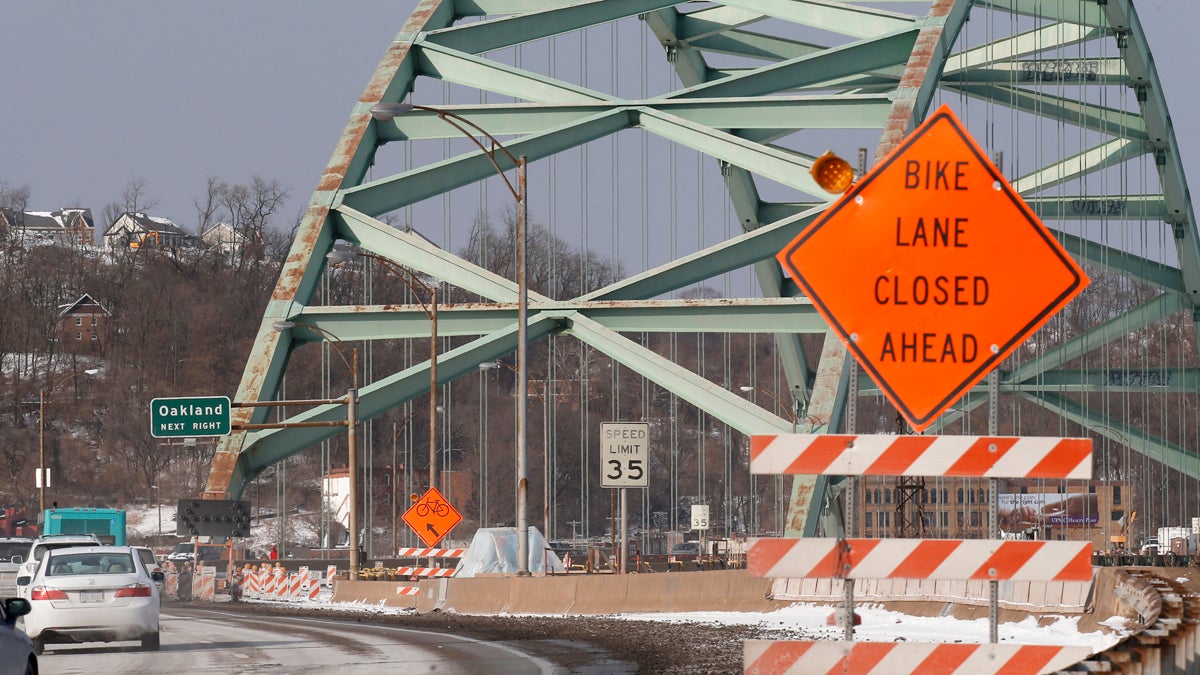Ideas Worth Stealing: Investing pension funds in infrastructure projects

File photo: In this photo made on Thursday, Feb. 19, 2015, a lane is blocked by construction equipment as work continues on the Birmingham Bridge that spans the Monongahela River in Pittsburgh. (AP Photo/Keith Srakocic)
Some large pensions funds around the world are funding infrastructure projects and getting returns. Could this be an option in Pa.?
Ideas Worth Stealing: Every week, Keystone Crossroads will look to cities across the world for lessons in urbanism and municipal governance that could benefit Pennsylvania. No city does it all right, and we hope these examples from metropolises near and far inspire and encourage cities here to think outside the box.
Two things Keystone Crossroads loves writing about? Infrastructure and pensions. In Pennsylvania, the former is old, in many cases deteriorating rapidly, and perpetually short of funds. The latter is underfunded by billions of dollars.
And the two are related: we previously reported that when pensions are not properly funded, things like infrastructure improvements can take a hit as more of the budget goes towards keeping pension funds afloat.
But it turns out pensions and infrastructure can cross paths in good ways, too.
Some U.S. pension funds are starting to consider investing in infrastructure, and large pension funds around the world are already doing it. Australia, Canada, the United Kingdom, and countries throughout Africa are investing their pension funds in infrastructure. In some cases these plans invest up to 15 percent of total assets in infrastructure, which can include everything from roads to telecommunications. Norway and Japan are considering it.
As a 2013 article from The Economist put it, it’s “a marriage made in heaven. Infrastructure projects take a long time to build but then deliver cash flows over an extended period. Pension funds have liabilities that stretch over several decades.”
But a 2014 report from the Organization for Economic Co-operation and Development (OECD) showed that of the 71 pension funds surveyed worldwide (Pennsylvania pension plans were not included in the survey), only one percent of total assets were invested in infrastructure projects.
Pennsylvania’s largest pension plans have limited infrastructure investments. PSERS, which covers public school employees, does not have any infrastructure investments. SERS, which covers state employees, invests 4 percent of its fund in commodities and infrastructure (though it’s not clear how much of that goes to infrastructure specifically). And PMRS, a state fund that manages aggregated smaller municipal funds, does not invest any assets in infrastructure and does not plan to in the near future, according to PMRS Assistant Secretary Kristine Cline.
Policy issues could be one reason for the relatively low investment in infrastructure by pension funds: inconsistent government policy and regulations can make infrastructure investment seem risky. According to the OECD report they’re more risky for other reasons, too, like having lower liquidity.
The OECD also says there’s not much of a track record on how well infrastructure investments perform. According to The Economist, “this makes it difficult for funds to calculate how infrastructure would fit into their portfolios: for example, whether its returns would be closely correlated with other assets, such as equities.”
“Another problem,” The Economist writes, “is that small pension funds may lack the expertise to get directly involved in such large projects; they have to invest via an infrastructure fund, and pay a management fee for the privilege.” For a complex, long-term investment like infrastructure that means considerable expertise and cost.
Yet another issue is that the municipal bond market provides relatively cheap money for capital projects – current returns are about 4 percent – and pension fund managers want to see returns larger than that. But Jill Eicher, director of the Pension Infrastructure Collaborative at Stanford University’s Global Projects Center, writes that “while capital at 4 percent appears cheap, borrowing costs are only the starting point in public infrastructure projects. Other costs, such as for operations and maintenance, ought to be considered — and too frequently aren’t — when taking on projects that might stretch out over 30 years. Governments and taxpayers would get far more value from investors willing and able to finance total life cycle costs than they do from a simple bond issuance.”
So why bother? Infrastructure is important. Infrastructure also means jobs. And infrastructure projects are expensive and always looking for money. Federal highway funding remains tenuous while President Obama pushes for more private investments in infrastructure. Obama specifically mentions pension funds as a potential source of money for infrastructure projects; a summit this spring was organized to advertise infrastructure as an alternative path for investors and to plan on how to make such investments easier for private funds. If pension plans can be a new funding source for infrastructure projects and still make money on their investments, it’s a win-win.
The largest public pension fund in the U.S., the California Public Employees’ Retirement System (CalPERS), announced that it’s going to increase its investments in infrastructure. The money will go towards water, power, transportation and energy projects in Asia. CalPERS is teaming up with the Queensland Investment Corp. (QIC), an Australian pension fund with experience in managing infrastructure investments. CalPERS plans to learn from QIC and eventually to manage the investments itself, without paying middlemen, another novel yet increasingly popular idea among pension plans.
Perhaps in the future Pennsylvania’s pension plan managers will consider infrastructure as part of their portfolios, as well. And perhaps they’ll consider investing in local infrastructure when they do.
WHYY is your source for fact-based, in-depth journalism and information. As a nonprofit organization, we rely on financial support from readers like you. Please give today.


